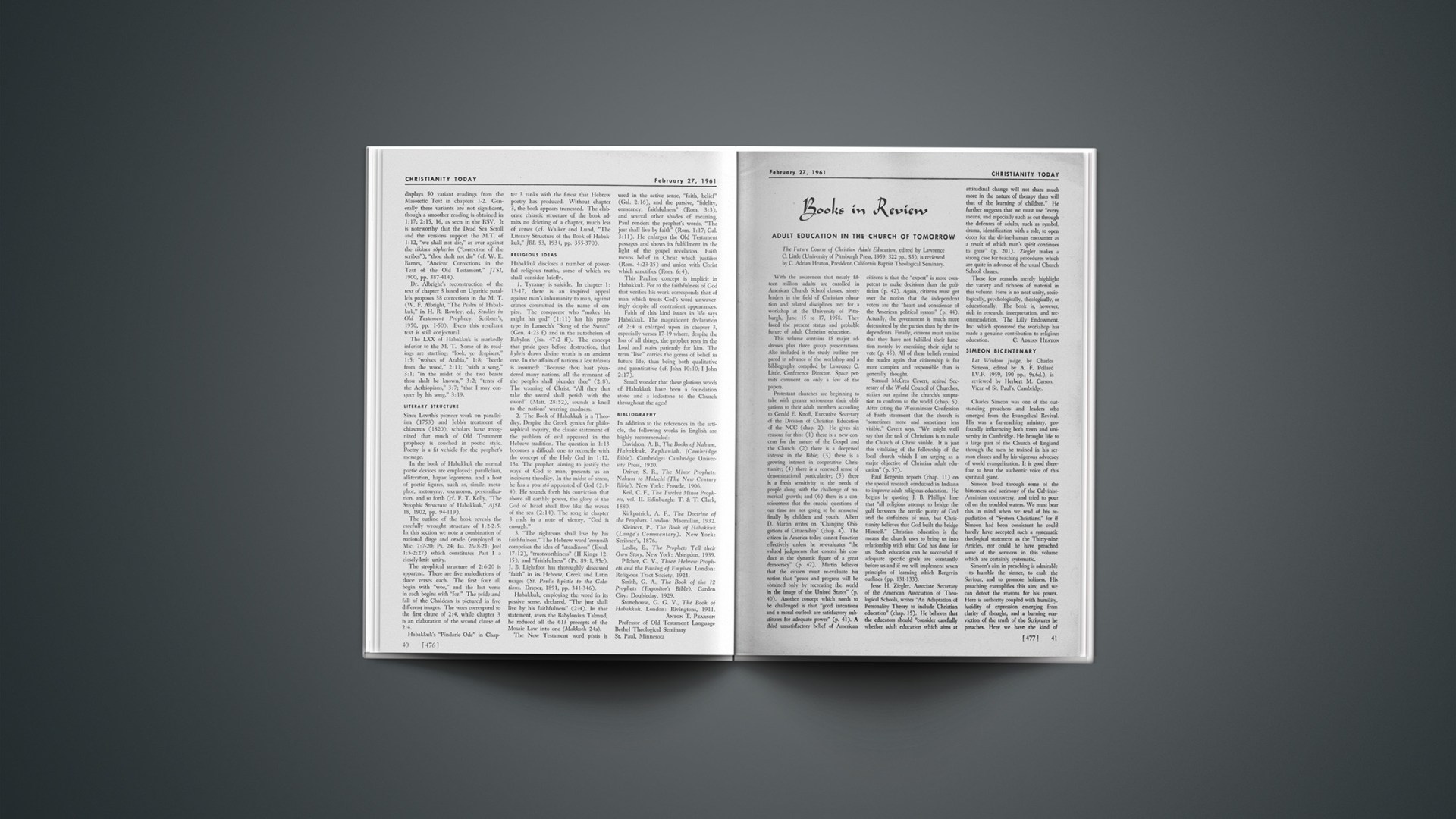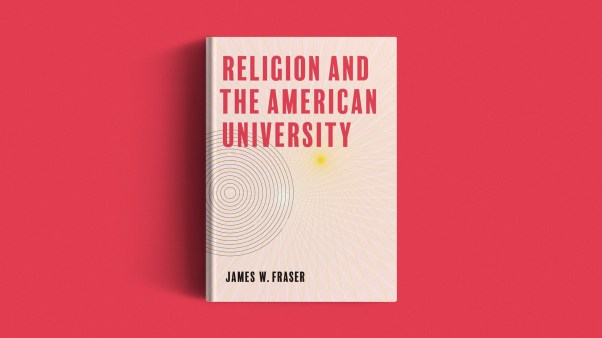Adult Education In The Church Of Tomorrow
The Future Course of Christian Adult Education, edited by Lawrence C. Little (University of Pittsburgh Press, 1959, 322 pp., $5), is reviewed by C. Adrian Heaton, President, California Baptist Theological Seminary.
With the awareness that nearly fifteen million adults are enrolled in American Church School classes, ninety leaders in the field of Christian education and related disciplines met for a workshop at the University of Pittsburgh, June 15 to 17, 1958. They faced the present status and probable future of adult Christian education.
This volume contains 18 major addresses plus three group presentations. Also included is the study outline prepared in advance of the workshop and a bibliography compiled by Lawrence C. Little, Conference Director. Space permits comment on only a few of the papers.
Protestant churches are beginning to take with greater seriousness their obligations to their adult members according to Gerald E. Knoff, Executive Secretary of the Division of Christian Education of the NCC (chap. 2). He gives six reasons for this: (1) there is a new concern for the nature of the Gospel and the Church; (2) there is a deepened interest in the Bible; (3) there is a growing interest in cooperative Christianity; (4) there is a renewed sense of denominational particularity; (5) there is a fresh sensitivity to the needs of people along with the challenge of numerical growth; and (6) there is a consciousness that the crucial questions of our time are not going to be answered finally by children and youth. Albert D. Martin writes on “Changing Obligations of Citizenship” (chap. 4). The citizen in America today cannot function effectively unless he re-evaluates “the valued judgments that control his conduct as the dynamic figure of a great democracy” (p. 47). Martin believes that the citizen must re-evaluate his notion that “peace and progress will be obtained only by recreating the world in the image of the United States” (p. 40). Another concept which needs to be challenged is that “good intentions and a moral outlook are satisfactory substitutes for adequate power” (p. 41). A third unsatisfactory belief of American citizens is that the “expert” is more competent to make decisions than the politician (p. 42). Again, citizens must get over the notion that the independent voters are the “heart and conscience of the American political system” (p. 44). Actually, the government is much more determined by the parties than by the independents. Finally, citizens must realize that they have not fulfilled their function merely by exercising their right to vote (p. 45). All of these beliefs remind the reader again that citizenship is far more complex and responsible than is generally thought.
Samuel McCrea Cavert, retired Secretary of the World Council of Churches, strikes out against the church’s temptation to conform to the world (chap. 5). After citing the Westminster Confession of Faith statement that the church is “sometimes more and sometimes less visible,” Cavert says, “We might well say that the task of Christians is to make the Church of Christ visible. It is just this vitalizing of the fellowship of the local church which I am urging as a major objective of Christian adult education” (p. 57).
Paul Bergevin reports (chap. 11) on the special research conducted in Indiana to improve adult religious education. He begins by quoting J. B. Phillips’ line that “all religions attempt to bridge the gulf between the terrific purity of God and the sinfulness of man, but Christianity believes that God built the bridge Himself.” Christian education is the means the church uses to bring us into relationship with what God has done for us. Such education can be successful if adequate specific goals are constantly before us and if we will implement seven principles of learning which Bergevin outlines (pp. 131–133).
Jesse H. Ziegler, Associate Secretary of the American Association of Theological Schools, writes “An Adaptation of Personality Theory to include Christian education” (chap. 15). He believes that the educators should “consider carefully whether adult education which aims at attitudinal change will not share much more in the nature of therapy than will that of the learning of children.” He further suggests that we must use “every means, and especially such as cut through the defenses of adults, such as symbol, drama, identification with a role, to open doors for the divine-human encounter as a result of which man’s spirit continues to grow” (p. 201). Ziegler makes a strong case for teaching procedures which are quite in advance of the usual Church School classes.
These few remarks merely highlight the variety and richness of material in this volume. Here is no neat unity, sociologically, psychologically, theologically, or educationally. The book is, however, rich in research, interpretation, and recommendation. The Lilly Endowment, Inc. which sponsored the workshop has made a genuine contribution to religious education.
C. ADRIAN HEATON
Simeon Bicentenary
Let Wisdom Judge, by Charles Simeon, edited by A. F. Pollard I.V.F. 1959, 190 pp., 9s.6d.), is reviewed by Herbert M. Carson, Vicar of St. Paul’s, Cambridge.
Charles Simeon was one of the outstanding preachers and leaders who emerged from the Evangelical Revival. His was a far-reaching ministry, profoundly influencing both town and university in Cambridge. He brought life to a large part of the Church of England through the men he trained in his sermon classes and by his vigorous advocacy of world evangelization. It is good therefore to hear the authentic voice of this spiritual giant.
Simeon lived through some of the bitterness and acrimony of the Calvinist-Arminian controversy, and tried to pour oil on the troubled waters. We must bear this in mind when we read of his repudiation of “System Christians,” for if Simeon had been consistent he could hardly have accepted such a systematic theological statement as the Thirty-nine Articles, nor could he have preached some of the sermons in this volume which are certainly systematic.
Simeon’s aim in preaching is admirable—to humble the sinner, to exalt the Saviour, and to promote holiness. His preaching exemplifies this aim; and we can detect the reasons for his power. Here is authority coupled with humility, lucidity of expression emerging from clarity of thought, and a burning conviction of the truth of the Scriptures he preaches. Here we have the kind of preaching we need today—clear exposition coupled with vigorous application of the word which emerges from Scripture, which was for Simeon the final authority.
HERBERT M. CARSON
Trends And Fashions
New Accents in Contemporary Theology by Roger Hazelton (Harper, 1960, 144 pp., $3), is reviewed by Carl F. H. Henry.
The author has done us the service of corralling (for the moment) some of the divergent trends in recent modern theology. The book focuses attention especially on “new accents”; pursuing the novel, it tends to ignore the theological enterprise in terms of evangelical stability. There is little emphasis on authoritative criteria, and consequently no awareness of heresy. The alert minister will want to be informed, nonetheless, of both legitimate trends and current fashions, and this work will prove a serviceable one. When Dr. Hazelton relates that “some of us have been learning … that a novel by someone who, like Faulkner or Camus, does not wish to be known as a Christian believer may come closer to the biblical and churchly truth about more than a Sunday morning sermon” (p. 14), he seems to forget, as many a modern theologian, that the Christian view of man is specially anchored in God’s revelation in Christ and the Scriptures. Readers will note the widening emphasis on church tradition (pp. 76 f., 84 f.), bridging toward Romanism, while evangelical confidence in “the faith once for all delivered” is narrowed.
CARL F. H. HENRY
Sure Foundation
Our Dependable Bible, by Stanley E. Anderson (Baker, 1960, 248 pp., $3.95), is reviewed by Faris D. Whitesell, Professor of Practical Theology, Northern Baptist Theological Seminary.
Here’s the book to put into the hands of young people and laymen who have been disturbed about the inspiration and dependability of the Bible. Written by one who loves the Bible and who has made a lifelong study of its reliability, Dr. S. E. Anderson, director of the correspondence department of Northern Baptist Seminary, makes a vigorous and forthright defense of the verbal inspiration and total trustworthiness of the Holy Scriptures. His thesis is that amid the conflicting opinions of uninspired men, the world needs a dependable cosmic compass or be forever lost. The Bible alone is the answer to that need.
The author insists that Christ’s attitude of acceptance and approval of the Scriptures should be ours. The overwhelming proofs from archaeology, from fulfilled prophecy, and from the Bible’s teaching about itself give a firm ground of faith to trust the Bible. Dr. Anderson marshalls the evidence clearly and convincingly until it is mountain high.
Adverse critics will not be persuaded. They will likely say that the book is overloaded with quotations (some not from men of highest scholarship), that it touches Barthianism too lightly and Bultmannism not at all, that it is slanted to the past rather than the present, and that it is too elementary. However, the reviewer can see nothing but good to the cause of Christ coming from the use of this book, for it builds faith not only in the Bible but in the God of the Bible, and this we all greatly need in these faith-testing days.
FARIS D. WHITESELL
Song Of A Warm Faith
The Presbyterian Way of Life, by John A. Mackay (Prentice-Hall, 1960, 238 pp., $3.50), is reviewed by William Childs Robinson, Professor of Historical Theology, Columbia Theological Seminary.
This is a beautiful volume by a distinguished church leader of rare gifts, wide contacts, and high position. His large vocabulary and alliterative use of language, which at times breaks out in a heart rhapsody, add to the charm. The purpose of the writer is not to give a detailed historical survey but an interpretation (p. 28); and since the author was at times a prime actor in what he records, the book becomes a kind of apologia pro vita sua. As such it represents the author’s own individuality and positions which are not always those of the reviewer.
The chapters on the understanding of God, of man, and of the Church will prove a blessing to the popular reader for which they are designed. The first is strengthened by references to the Psalms in the Free Church tradition in which the author was reared. The one on man is enriched by references to the Shorter and the Heidelberg Catechisms. In these quotations one finds the single clear statement that Christ with his precious blood has fully satisfied for our sins and that his righteousness is imputed to us and received by faith alone. This is the heart of the Reformed faith. There is a good emphasis on the Church and a call to seek discipline without disruption. The recognition of the Lord as the servant with the obligation of the Church and the believer to carry on the servant image is excellent. Indeed, the Lordship of Jesus Christ, the presence of the Holy Spirit is power, the beginning of all thinking with God—the God who spared not his only Son and who has gripped our lives in a vital encounter—are the great notes in this book.
The statement on page 7 that in Presbyterianism “the ultimate authority is vested in Presbytery” could make that court as absolute as a Hildebrand or a Hitler would wish. But the real meaning of the author seems to be to exalt the presbytery above the higher courts in the matter of deciding whether a candidate for ordination is to be received despite his scruples with regard to certain Presbyterian doctrines. Certainly, as this book and as the constitution of the UPUSA Church set forth, the General Assembly is in important ways above the Presbytery. Our own view is that every court in the Presbyterian system gets its authority directly from Jesus Christ, the Head and King, whose authority alone is ultimate. In his historical treatment, Dr. Mackay has ignored the Adopting Act of 1729 which gave the Synod, then the highest court of the church as well as Presbytery, authority to decide which articles were necessary and essential for ordination. The book is a valuable warning against absolutizing any parts of the faith; it does not give a clear answer as to how the church is to safeguard the faith once delivered to the saints.
In the interest of interpretation, there are details which need questioning. Calvin seems to have written on all the books of the New Testament except Revelation, and on many, not all, of the Old Testament (p. 10). His views can hardly be called baptized Stoicism (p. 8), since he said, “For ourselves we have nothing to do with this iron philosophy which our Lord and Master condemned not only in word but also by example, cf. Matt. 5:4.” The account of and references to the affair of Servetus are marked more by subjective interpretation than by factual detail (pp. 13–15, 207). Calvin did more than consent to his execution; he was the religious prosecuting attorney. On the other hand, he vigorously opposed burning as the method of execution. Calvin’s was not a momentary seizure but a settled position as, in his opinion, the only way to show that the Protestants were not encouraging Servetus’ heresies on which charge the evangelicals were being burned in France. There is no evidence that “To the end of his days he could not forgive himself for Servetus’ death.”
The chapter on worship may be the high peak of the book. Would that every Presbyterian and every Christian minister might take to himself the exhortation to preach the Word under the Lordship of Christ, and lead the extempore prayers with the warm heart, the scriptural preparation, and the Spirit’s presence as is here commended. The warning to those who minister in cathedral-like environments with the support of elaborate choirs and ritual lest “The hungry sheep look up and are not fed” is most timely. So is the following warning against pressing a current fad too far: “To be a pastor, to have a shepherd’s heart, to be sensitive to human need, to know out of one’s own faith and experience how to meet this need, without having to recur everlastingly to a psychiatrist, is or should be the “way” of the Presbyterian minister. Were the Good Shepherd always followed in our time by his under shepherds, agitated human spirits would be given spiritual food as well as psychological diagnosis and advice. They would be introduced to the divine Redeemer and not chiefly to that new Divinity whose name is the Analytical.”
The presentation of the Lord’s Supper is more thoroughly Calvinistic than is the discussion of the questions asked for Baptism. In the case of the latter the emphasis seems to be wholly on what man does, i.e., the parents or the adult candidate. Could the Presbyterian Church US ask its larger and elder sister the Presbyterian Church UPUSA to take a leaf at this point from our Book of Church Order in which the parents are asked to acknowledge their child’s need of the cleansing blood of the Lord Jesus Christ and the renewing grace of the Holy Spirit, to claim God’s covenant promises in his or her behalf and look in faith to the Lord Jesus Christ for his or her salvation as for their own?
It is quite interesting to have President Mackay on page 124 declare that Presbyterians will not accept as a precondition of union reordination by a “historic episcopate” or submit to the hands of a bishop being laid on them at the very time when Stated Clerk Dr. Carson Blake is proposing a four-way denominational merger which envisages what Mackay here repudiates in no uncertain terms.
One gets the impression that Mackay wants to carry over into the Presbyterian Way of Life the faith of his old pastor, Principal John Macleod, and of his old professor, Dr. B. B. Warfield, and that he does not quite know whether they will fit into the broadening church of his ecumenism. Yet one has also the feeling that this is written by the noted ecclesiastic as perhaps his swan song with the lyric of eternity in his soul and the Christian hope in his heart.
WILLIAM CHILDS ROBINSON
Nebulous Faith
Christian Belief and Science, by Robert E. D. Clark (English Universities Press, 1960, 160 pp., 12s 6d), is reviewed by Arthur F. Holmes, Director of Philosophy, Wheaton College.
This book, written by a scientist who is also a committed Christian, is an attempt to relate religious faith to scientific reason via the phenomenon of intuition. The author draws upon examples of scientific imagination which facilitated new discovery, likens them to physical occurrences such as mental telepathy, and then assimilates religious faith to the psychological model thus established.
As with all too many treatments of the relationship of faith to reason, it suffers from a failure to understand sufficiently the nature of the end-terms involved. Reason is defined very loosely, as the ability to arrange our thoughts in order (p. 9), with the result that the role of reason in both science and religion is grossly underestimated. At times the scientist-author actually calls logic the “enemy” of science and claims that “discovery comes when the rational mind is asleep” (e.g., p. 32). Even sensory knowledge, we are told, sometimes bypasses the mind. The discovery of truth is taken to be intuitive, accompanied by firm conviction and great joy. Yet for all the eminent “success” of intuition, science is still more often wrong than right (p. 9). A more careful analysis of both reason and intuition would show a much closer affinity between analytic and spontaneous thought than this allows.
Similarly Clark defines faith very loosely, as an intuition analogous to mental telepathy (e.g., pp. 119, 137). The reader is left with the suggestion that faith arises in an intellectual vacuum and is barely distinguishable from credulity. This poses two problems. First, it implies that revelation is a subjective and non-cognitive “hunch.” At no point which this reviewer observed did the author indicate the objectivity revelational character of Scripture; at one point he advised Bible reading as having “brought a sense of certainty and conviction into the minds of men and women” (p. 154). This may be true, but is not faith an intelligent commitment to the God in Christ as set forth in the Biblical revelation, and therefore more objective, cognitive and defensible than an act of intuition?
Secondly, to identify faith with intuition tends to divorce faith from reason. The author detects the danger, and concedes that reason has value in clarifying faith and in helping to prevent its being undermined. The role of reason in the genesis of faith is omitted. Even its subsequent role is restricted by the assertion that “if by thinking we alter the faith we are examining then we act foolishly and wrongly” (p. 119). On the contrary, one cannot expect that early and somewhat naive faith should for ever go unrefined. It is not enough, for instance, to reiterate uncritically the distorting oversimplification that in the Incarnation God appeared in a human body. This “faith” should be “altered.”
A verdict is difficult. The thesis may reflect the influence of someone like Bergson, or it may represent the brave attempts of a fine scientist to discuss issues outside his field. Scientific competence does not qualify one to discuss authoritatively questions in epistemology and the philosophy of religion. The book is attractively presented and very readable.
ARTHUR F. HOLMES
On War’S Edge
St. John’s Gospel, by Walter Lüthi, translated by Kurt Schönenberger (John Knox Press, 1960, 348 pp., $5), is reviewed by Merrill C. Tenney, Dean of the Graduate School, Wheaton College (Illinois).
A Swiss pastor, preaching during the turbulent years of the Second World War “on the edge of the crater,” has given us a new exposition of the Gospel of John. Driven back to the Bible by the crushing problems of his age, he has found a fresh message in the Gospel which rationalists had condemned as “unhistorical” and had consequently ignored. With penetrative discernment he selects the truths which may be applied to current life, and expounds them with lucidity and skill. There is much food for profitable thought in these sermons.
Theologically, the writer is existential in his approach. All of his teaching is geared to the immediate moment of the individual, or to problems of experience. He attempts no systematic presentation of Johannine theology, and his viewpoint is mystical rather than creedal. This tendency is best illustrated in his chapter on “The Resurrection of Christ” in which he says, “Easter is not a return to the temporal world, but a breakthrough into eternal life. Between Mary Magdalene and the risen Lord there now lies that mysterious barrier that divides this world from the beyond, time from eternity, and God from us men.” Lüthi does not deny the physical realities of the resurrection; on the contrary, he asserts that Thomas touched the body of the risen Lord. Rather he treats the evidence as secondary in importance to the application of spiritual truth, and presses upon his congregation the meaning of the principles laid down in the Gospel without discussing technicalities.
Much that is helpful will be found in this book. The simplicity and directness of its language, and its positive affirmation of the authority of Christ commend it to readers who wish to see how the Fourth Gospel is relevant to their experience. It is, however, homiletical rather than exegetical, and is in no sense a full commentary on John, nor is it a complete guide to Johannine thought.
MERRILL C. TENNEY
Socialist Reformation?
The Reformation, by Archibald Robertson (Watts, 1960, 232 pp., 21s.), is reviewed by Gervase E. Duffield, Secretary to the Tyndale Fellowship for Biblical Research, Cambridge.
“Scientific advance … has rendered both the Catholic and the Reformed theologies obsolete. The battle of ideas has shifted from the interpretation of scripture to the interpretation of nature and of human institutions. New conditions … have made possible a worldwide Socialist movement based on a scientific analysis of history and society” (p. 219).
This is the author’s conclusion, in a book which starts with a brief survey of medieval Europe and traces the Reformation through to the outset of the seventeenth century. It is perhaps good for Christians to be reminded that politics and class struggles were mixed up in the sixteenth century upheavals, and Mr. Robertson is at his best when dealing with matters like the political intrigues of Spain in the Netherlands, or the plots and counterplots centering round the Guise family in France, or the Jesuit attempts to overthrow Queen Elizabeth and bring England back to Rome. In the last he rightly shows that these papists were guilty of treason, and were not “the faithful martyrs” of Romanist hagiography. Yet he does not understand the theological issues, and one might almost think the Reformation was concerned with politics and economics, and religion simply provided a useful pretext! The idea of a book covering the whole European Reformation in brief outline is a good one, especially when we have a chronological chart and a good index included, but this work is too inaccurate. As footnotes never give page numbers, and sometimes not even chapters, the checking of doubtful statements becomes impossible. Luther did not mark the beginning of modern Biblical criticism (p. 66); Lorenzo Valla, Erasmus, and a host of others preceded him. Calvin was not the trusted adviser of the Genevan government from 1541 onwards (p. 135); in fact, he frequently had to oppose the Libertine dominated councils. The 1552 Prayer Book was not Zwinglian (p. 156). And did Zwingli become a Reformer for political reasons primarily (p. 175)? Is it fair to speak of Cranmer’s unceasing subservience to Henry (p. 153)? And why Elizabeth’s condemnation of Mary Queen of Scots is justifiable only on the principles of Calvin and Knox is quite unintelligible (p. 107).
This book is an interesting revelation of just how far an author who sets out to read class warfare into history can go. Occasional references to Engels give us the clue to the author’s leftwing outlook. Despite the amount of ground this work covers, and the good patches, it is not a trustworthy guide. We learn as much about Mr. Robertson’s prejudices as we do about the Reformation.
GERVASE E. DUFFIELD
World Peace
The Religious Foundations of Internationalism, by Norman Bentwich (Bloch, 2nd ed., 1939, 303 pp., $5), is reviewed by W. Stanford Reid, Associate Professor of History, McGill University, Montreal.
Originally delivered in 1932 as a series of lectures at the Hebrew University, Jerusalem, on Professor Bentwich’s inauguration as incumbent of the Weizmann Chair of the International Law of Peace, this work now appears in its second edition. Basing his argument on what one might call a comparative religion interpretation that all religions lead to God, Professor Bentwich holds that “religion” as such will provide a suitable foundation for true internationalism.
In studying this work, one quickly realizes that it has serious weaknesses. Most obvious to the reviewer was the author’s old-fashioned liberal interpretation of Judaism and Christianity. The nineteenth century theme of “the fatherhood of God and the brotherhood of man” dominates the book. One cannot but suspect that perhaps his interpretation of Islam, Buddhism, and other religions mentioned similarly misses the point. Likewise there are obvious historical inaccuracies. Written also with high hopes in the League of Nations, the book is obviously dated, so that one cannot but wonder at its republication.
The final chapter which was added for this new edition, reveals the author’s disillusionment with his own thesis. Religion is becoming increasingly tied to a violent nationalism—as for instance in the case of Islam and even African paganism. Consequently the old optimism does not appear in this more recent addition. Perhaps his most important conclusion is that man must experience a change of heart if he would find peace. To this every Christian will assent, but he will also hold that such peace only comes by God’s action, accompanied by the preaching of the Gospel of Christ.
W. STANFORD REID
Imaginative Sermons
Unconquerable Partnership, by Reuben K. Youngdahl (Augustana Press, 1960, 258 pp., $3), is reviewed by Andrew W. Blackwood, Professor of Homiletics, Emeritus, Princeton Theological Seminary.
This volume contains inspirational sermons by the pastor of the largest Lutheran congregation in America. Evangelical in content, these messages show how to attract and hold throngs of city folk, especially the young people. We who plead for a popular Bible teaching ministry ought to study this volume. It shows how to use present-day methods in securing variety and appeal to human nature by profuse use of illustrations from personal experience and observation, life in the homeland today, biography, and travel in mission fields. On the whole, this is the most interesting book of sermons that I have read of late. Why do not more of us orthodox preachers excel in simplicity, resourcefulness, and appeals to the imagination? These were the qualities that marked the popular speaking ministry of our Lord.
ANDREW W. BLACKWOOD
The Church In Red China
Come Wind Come Weather: The Present Experience of the Church in China, by Leslie T. Lyall (Moody Press, 1960, 95 pp., $2), is reviewed by Margaret Sells, Missionary in Taiwan.
The author, many years a missionary to China, presents an objective, well-documented account of the Protestant Church in Red China today. Lifting aside the Communist-devised “Propaganda Smoke Screen,” he reveals Communist methods for rooting out Christian belief.
He answers such questions as: “How has the church become wedded to the state?” “What happens to Christians who refuse to compromise?” “What has become of China’s historic family system?” “What is the ‘Three-Self Patriotic Movement’?”
The book will be a guide to intelligent prayer for our Chinese brethren. Every American should read it. It may well be an expose of the pattern of things to come.
MARGARET SELLS
Book Briefs
Dead Stones with Living Messages, by Bob Boyd (Hall, 1960, 182 pp., $4.95). Bible archaeology made interesting for laymen. Profusely illustrated.
Love is a Spendthrift, by Paul Scherer (Harper, 1961, 230 pp., $3.75). Stimulating daily meditations in the pattern of the Christian Year—from Advent to Trinity.
Seven Words to the Cross, by Robert F. Jones (John Knox, 1961, 92 pp., $2). Unique series of vesper meditations based on reactions of people who saw Christ crucified.
Bibliography of the Theology of Missions in the Twentieth Century (second edition, revised and enlarged), compiled by Gerald H. Anderson (Missionary Research Library, 1960, 79 pp., mimeographed, $1.50). A comprehensive, classified bibliography of books and essays on the topic of the theology of Christian world mission.
An Admiral’s Log II: In Search of Freedom, by Ben Moreel (IAI, 205 pp., no price given). A noted Admiral of the U. S. Navy views, with some spiritual overtones, the American social and political scene.
My Father’s World, by David Hood (Zondervan, 1960, 124 pp., $1.95). A Bible-based sermonic journey through God’s great out-of-doors.
The Labor of Love, by Spiros Zodhiates (Eerdmans, 1960, 376 pp., $4). Second in a three-volume exposition of the Epistle of James, based on a close scrutiny of the original Greek text.
Seasons of the Soul, by Archibald F. Ward, Jr. (John Knox, 1960, 135 pp., $3). Beautiful poetic translations of 100 selections from the Psalms designed to comfort and inspire those who are ill or discouraged.
The Reconciling Gospel, by Culbert G. Rutenber (Judson, 1960, 183 pp., $1.50). Written for American Baptist Convention use, it seeks to provide a theological undergirding for evangelism.
The Rough Years, by Chad Walsh (Morehouse-Barlow, 1960, 266 pp., $3). An exciting new novel about and for teen-agers with a Study-Guide ($1.50) for group discussions by Edward T. Dell, Jr. Youth organizations seeking imaginative and challenging meeting techniques will welcome these volumes.
A Bibliography of Bible Study for Theological Students (second revised and enlarged edition) (Princeton Theological Seminary, 1960, 107 pp., $1). An inclusive bibliography confined to theological works on the Bible, in the English language, and to linguistic helps in the biblical languages.
The Soviet Union from Lenin to Khrushchev, by David J. Dallin (U. S. Government Printing Office, 1960, 367 pp., $1.25). Vol. 2 of Facts on Communism, a series of scholarly works prepared under the auspices of the Committee on Un-American Activities of the U. S. House of Representatives.










